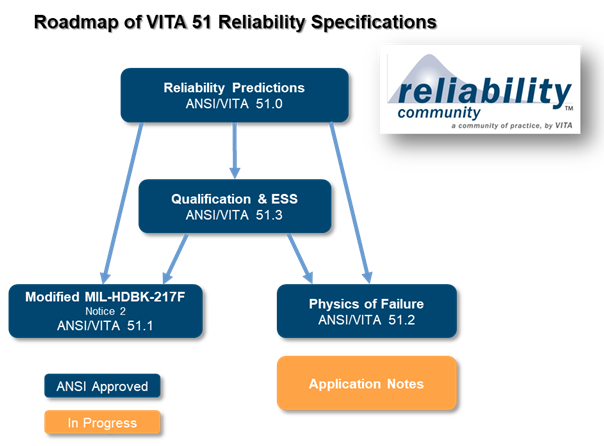Vi-ta [vee-tuh] | Critical Embedded Systems are everywhere . . . Become a leader in setting new directions! |
| Reliability Community by VITAThe Reliability Community is a collaborative effort by VITA members to develop a series of standards and guidelines to establish reliability practices for the Critical Embedded Computing industry. The community is comprised of representatives from electronics suppliers, system integrators, and the Department of Defense (DoD). These members have developed community of practice documents that define electronics failure rate prediction methodologies and standards. OverviewFailure rate predictions have been utilized by logistics and systems engineers for a myriad of purposes, including reliability analysis, cost trade studies, availability analysis, spares planning, redundancy modeling, scheduled maintenance planning, product warrantees and guarantees. In the 1950’s, electronics reliability models were derived and standardized by the DoD through the analysis of historical failure data. In 1961, the first edition of MIL-HDBK-217 was published, providing a basic reliability analysis tool that is still in use today. In 1994, U.S. Secretary of Defense William Perry published his pivotal memorandum titled “Specifications & Standards - A New Way of Doing Business.” This memo, and the changes in military acquisition that followed, caused many military standards to be cancelled in favor of commercial standards and practices. A consequence of this memo is the DoD is no longer updating MIL-HDBK-217, but is looking to industry organizations to provide updated reliability prediction methods. The Reliability Community working group was formed to investigate and develop industry standards to address electronics failure rate prediction and assessment. Where applicable, these standards provide adjustment factors to existing standards. As new electronics technology is developed, new methods will be developed, documented and added to future releases of these standards and subsidiary specifications. ScopeThe Reliability Community addresses the limitations of existing prediction practices, with a series of subsidiary specifications that contain the “best practices” within industry for performing electronics failure rate predictions. The Reliability Community recognizes there are many industry reliability methods, each with a custodian and acceptable practices to calculate electronics failure rate predictions. If such a method is identified as requiring additional standards for use by electronics module suppliers, a new subsidiary specification will be considered by the Reliability Community working group. PurposeThe purpose of the Reliability Community is to establish an ecosystem of interested parties that promotes and creates reliability practices. Electronics failure rate predictions are typically used for comparative assessments, reliability analysis, cost trade studies, availability analysis, spares planning, redundancies modeling, scheduled maintenance planning, product warrantees and guarantees. Reliability predictions are not meant to represent the field reliability (i.e., Mean-Time-Between-Maintenance, Mean-Time-Between-Removals, etc.). VITA 51.0 and the subsidiary specification VITA 51.1 define consistency and repeatability for mean time between failure (MTBF) calculations. VITA 51.3 provides information on how qualification levels and environmental stress screening (ESS) influences reliability. VITA 51.2 defines standard methods for using physics of failure in reliability prediction.
LinksReliability and Maintainability Symposium (RAMS), 2011 Proceedings - Annual Reliability and Maintainability Symposium (RAMS), 2010 Proceedings - Annual RMQSI Knowledge Center, a community resource for Reliability, Maintainability and Quality (RMQ) products and expertise Presentations and Whitepapers
Reliability predictions to support a design for reliability program Industry consensus approach to physics of failure in reliability prediction |


